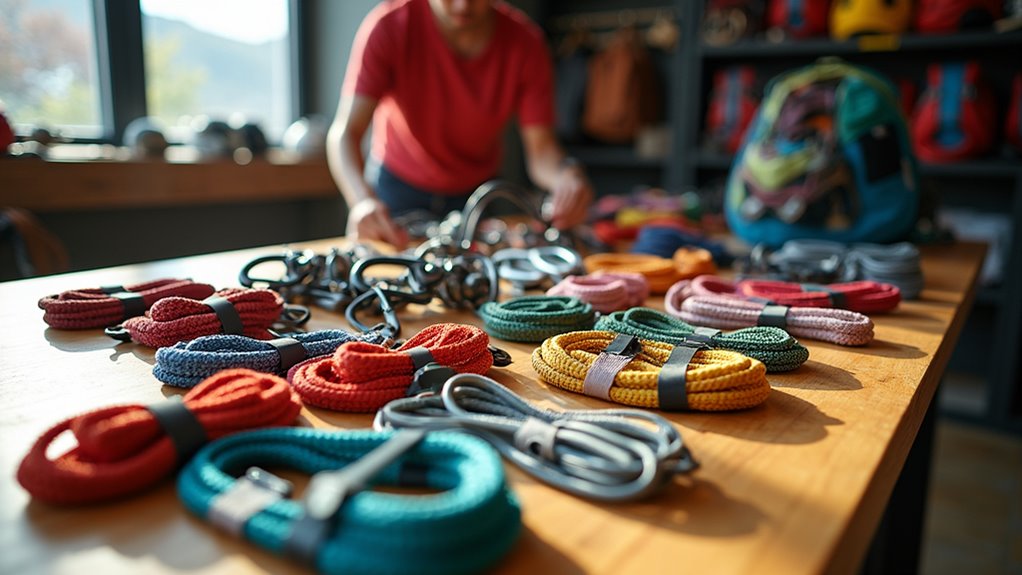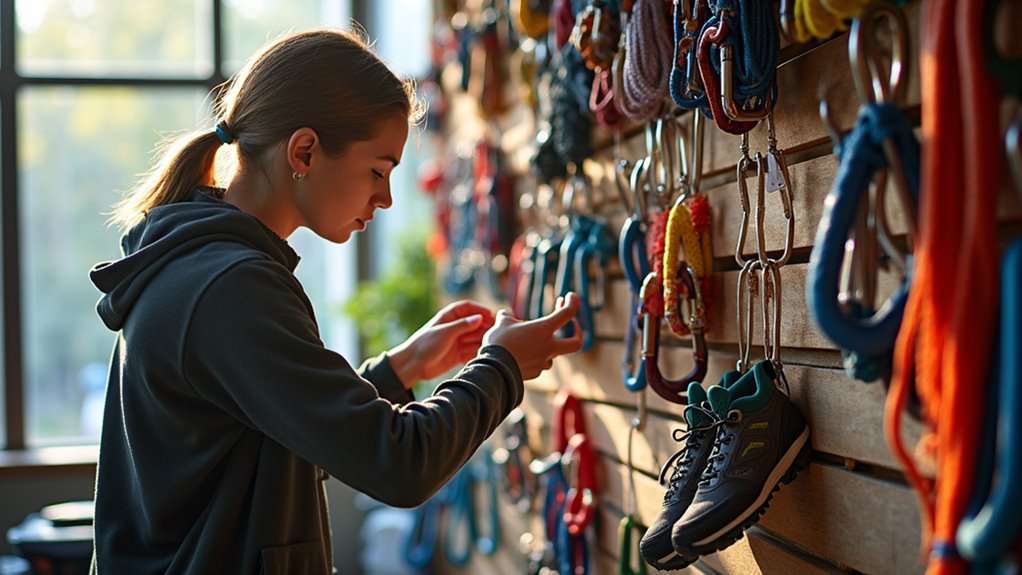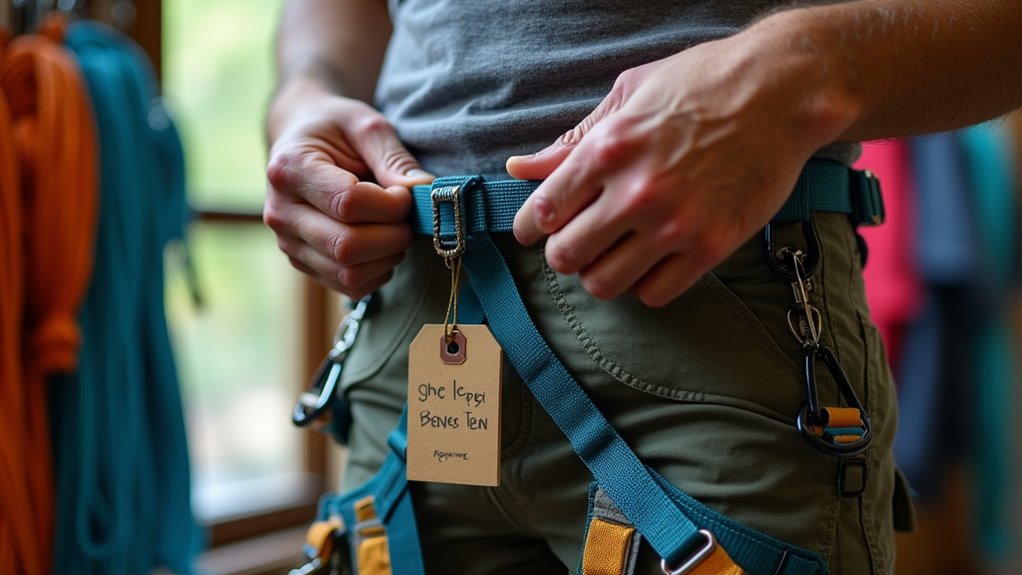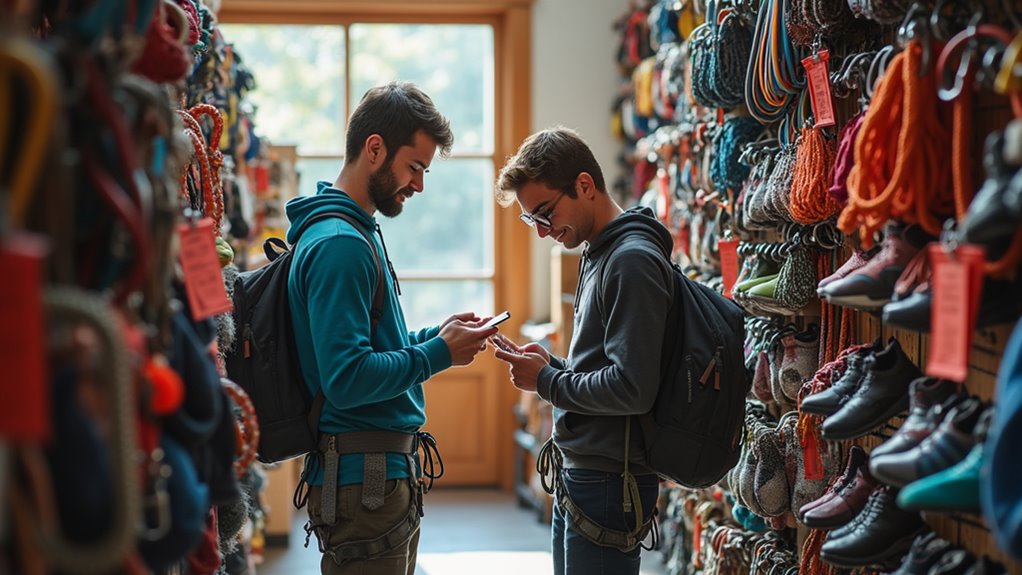Physical Address
304 North Cardinal St.
Dorchester Center, MA 02124
Physical Address
304 North Cardinal St.
Dorchester Center, MA 02124

Transform your climbing gear shopping experience with money-saving secrets that keep you safe without emptying your wallet.
You don’t have to break the bank to get reliable climbing gear, but you’ll need to be strategic about your purchases. Whether you’re a beginner or looking to upgrade your equipment, knowing how to shop smart can save you hundreds while ensuring your safety. From timing your buys during sales to understanding which certifications matter most, these seven practical tips will help you build a dependable climbing kit that fits both your needs and budget.

Choosing your climbing style is the essential first step before investing in gear. Each type of climbing demands different equipment and financial commitments, so you should aim to match your purchases to your goals.
Make informed gear choices by first deciding which climbing style matches your interests and aspirations.
If you’re starting out, consider top rope climbing. You’ll need basic gear like a harness, rope, and belay device, and you can often share anchor materials with partners. Free climbing techniques allow you to focus on your body movements while using the rope only for safety.
For bouldering, you’ll make the smallest investment, focusing mainly on shoes, chalk, and a crash pad. Sport climbing requires a moderate investment in quickdraws and rope, while trad climbing demands a substantial investment in protection gear.
Alpine climbing needs the most extensive gear collection, including specialized equipment for varying conditions.
Don’t rush to buy everything at once. Start with the essentials for your chosen style and expand your gear collection as your skills develop.
When purchasing climbing gear, understanding safety certifications is crucial for making informed decisions that protect your life.
Look for gear that carries both UIAA and CE certifications – these are the gold standards in climbing equipment safety. The UIAA certification involves rigorous testing specific to climbing scenarios, while CE marking is mandatory for gear sold in Europe and indicates compliance with essential safety requirements.
For helmets, check for both UIAA-106 and EN 12492 certifications, which guarantee proper protection against impacts and falls. The Safety Commission reviews standards regularly to ensure they meet current safety needs in the climbing world. Choosing the right gear is essential for a safe and enjoyable climbing experience.
You’ll find these certification numbers on the product or in its manual. Don’t skip checking the documentation – legitimate gear always includes certification details and lab testing information.
While certified gear might cost more, it’s an investment in your safety that you shouldn’t compromise on.

Anyone can buy climbing gear online, but you should consider testing equipment in person before making your purchase.
When trying on a harness, make certain you can move freely while maintaining safety. Your climbing shoes should feel snug without causing pain, allowing precise foot placement during climbs. For beginners, choosing a standard all-around harness is recommended.
Don’t overlook the importance of helmet fit – it should be secure without limiting your vision or comfort. If you’re planning to climb in cold conditions, test gloves for proper grip and flexibility.
Always verify that your belay device works smoothly with your chosen rope diameter. Before finalizing your purchase, check that all your gear components are compatible with each other.
Your chalk bag should attach easily to your harness, and any accessories like headlamps should fit well with your helmet. Knowing the 5 W’s can help ensure a successful beginner camping trip.
After testing and confirming proper equipment fit, you should aim to build your climbing gear collection strategically.
Start with the absolute essentials: a well-fitted harness, reliable climbing shoes, and a certified helmet for safety. Next, add a quality belay device and rope that meet UIAA standards.
Prioritize core climbing safety equipment first – properly fitted harness, dependable shoes, certified helmet, and UIAA-approved belay device and rope.
Once you’ve secured these fundamentals, gradually expand your collection based on your climbing style. If you’re into sport climbing, invest in quickdraws and a chalk bag. Regular inspections of your climbing hardware are critical for maintaining safety standards.
For outdoor climbing, you’ll need protective gear like sunscreen, first aid supplies, and emergency equipment. Essential camping gear can also be useful for outdoor climbing adventures.
Don’t feel pressured to buy everything at once – it’s smarter to invest in high-quality core items first and add accessories as your skills and needs develop.
Keep your budget focused on safety-critical items before considering convenience gear.

Since climbing gear represents a significant investment, choosing versatile equipment that delivers long-term value will maximize your budget and performance.
Look for harnesses with adjustable features and multiple gear loops that’ll accommodate different climbing styles and seasonal changes. When selecting protection gear, build a balanced rack with both passive and active pieces to handle various crack sizes and formations. The Petzl Sirocco helmet proves exceptional for its superior impact protection and lightweight design.
Don’t forget to prioritize durability in your rope choice, aiming for a mid-range diameter around 9.8mm that’ll serve you well across different climbing disciplines.
Proper maintenance of climbing gear is essential for both safety and longevity of your investment. When shopping, consider how much time and effort you should plan to spend maintaining each piece of equipment. You’ll need to inspect ropes, harnesses, and carabiners before every climb, while performing detailed checkups every few months on less-used items.
Choose gear that’s easy to clean and store properly. You should aim to keep your equipment in a cool, dry place away from UV exposure and chemicals. Metal gear components typically have a 10-year lifespan with proper care.
Keep climbing gear in a cool, dry area protected from sunlight and harsh chemicals to maintain its integrity.
Remember that ropes require regular checks for soft spots and sheath damage, while harnesses need inspection for wear and loose stitching. Metal gear like carabiners needs protection from moisture and corrosion.
Factor these maintenance requirements into your purchasing decisions, as proper care will save you money by extending your gear’s lifespan.

Finding quality climbing gear at reasonable prices requires knowing where and when to shop. You’ll find great deals at REI Outlet, Steep & Cheap, and GearX, with discounts ranging from 30% to 65% off retail prices.
To maximize your savings, shop during off-season sales and end-of-season clearance events when retailers clear out their inventory. Top brands like Scarpa offer substantial markdowns on popular models, with savings of up to $30 on shoes like the Reflex VS.
Don’t forget to check outlet sections of major retailers for last season’s gear at reduced prices.
Many stores also offer additional savings through loyalty programs and seasonal promotions, making it easier to build your climbing kit without breaking the bank.
Smart climbing gear shopping isn’t just about saving money—it’s about your safety and enjoyment. With climbing gear costs averaging $500-1,500 for a basic setup, you should aim to make informed decisions that balance quality and value. Remember to prioritize essential safety equipment, stay updated on certification standards, and leverage sales opportunities. By following these tips, you’re equipped to build a reliable climbing kit without breaking the bank.